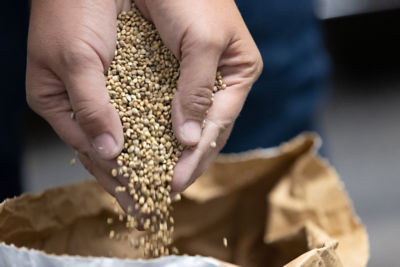Distribution
Worldwide
Blossom-end Root
Symptoms:
The blossom end of the fruit develops a dark leathery appearance. Symptoms may progress until the entire end of the fruit turns black and rots.
Conditions for Disease Development:
This disorder is associated with insufficient calcium uptake and alternating periods of wet and dry soil. Damage to the root system may also account for decreased calcium uptake and the development of blossom-end rot.
Control:
Minimized by mulching to maintain constant soil moisture, applying calcium fertilizers and avoiding high levels of nitrogen. Drip irrigate crop to control water management.
 Watermelon blossom-end rot. (Courtesy of Gerald Holmes)
Watermelon blossom-end rot. (Courtesy of Gerald Holmes)
 Squash blossom-end rot. (Courtesy of Gerald Holmes)
Squash blossom-end rot. (Courtesy of Gerald Holmes)
Hollow Heart
Symptoms:
Cracks in internal watermelon fruit flesh can occur due to accelerated growth in response to ideal growing conditions.
Conditions for Disease Development:
There is a genetic component to this disorder, but growing conditions can account for much of the variation observed. It appears to be associated with conditions that result in poor pollination (enough pollination to set the fruit but not enough to fertilize a high percentage of the ovules) followed by rapid fruit growing conditions (too much fertility, water and high temperatures).
Control:
Avoid watermelon varieties with a tendency to exhibit hollow heart. Implement best practices for irrigation and fertilization programs.
 Watermelon with hollow heart.
Watermelon with hollow heart.
Light Belly Color
Symptoms:
This disorder is characterized by the undersurface of cucumber fruit remaining light in color instead of turning dark green.
Conditions for Disease Development:
Commonly occurs on fruit lying on cool, moist soil.
Control:
Can be partially controlled by avoiding luxuriant vine growth. Avoid excessive nitrogen.
 Cucumber with light belly.
Cucumber with light belly.
Measles
Symptoms:
Symptoms are most evident on smooth-skinned melons and cucumbers. Small brown spots are scattered over the surface of the fruit. The spots are superficial and do not penetrate beyond the outer epidermal layers of the fruit. These spots also may occur on leaves and stems.
Conditions for Disease Development:
Associated with environmental conditions favoring guttation. The guttation droplets develop high concentrations of salts which burn the epidermis. Measles spots occur where a guttation droplet had formed.
Control:
Control measles by reducing irrigation frequency and duration as fruit approach maturity in fall-harvested crops. Irrigation reduction at the later stages of fruit development has not shown any adverse effects on fruit size and soluble solid content.
 Honeydew Melon with Measles
Honeydew Melon with Measles
Rind Necrosis
Symptoms:
Generally occurs in either cantaloupe or watermelon as dead, hard, dry reddish-brown to brown spots or patches of tissue in the fruit rind. Affected areas vary in size from 3mm (1/8″) spots to extensive dead areas throughout the entire rind. In watermelon, symptoms are not visible from the outside and are rarely found in the flesh. In cantaloupe, dead tissue may extend into the flesh of the fruit. Circular, water-soaked depressions also develop on the cantaloupe fruit surface.
Conditions for Disease Development:
Not well understood. However, it is thought that environmental conditions which place stress on the plants may trigger the onset of this disorder. Susceptibility to rind necrosis varies among varieties. The disorder occurs sporadically and is thought to be associated with bacteria that may be present in fruit, but the reasons for symptom development are not understood. Drought stress also is reported to predispose melons.
Control:
Genetic tolerance has been identified in watermelon. Avoid drought stress in melon.
 Rind necrosis on a triploid watermelon. (Courtesy of Brenda Lanini)
Rind necrosis on a triploid watermelon. (Courtesy of Brenda Lanini)
 Rind necrosis on watermelon.
Rind necrosis on watermelon.
Sunscald
Symptoms:
Papery white areas develop on fruit.
Conditions for Disease Development:
Develops during hot summer weather when fruit are suddenly exposed to direct sunlight.
Control:
Minimize by maintaining strong vine growth to ensure the fruit is covered.
 Melon sunscald. (Courtesy of Gerald Holmes)
Melon sunscald. (Courtesy of Gerald Holmes)
 Pumpkin sunscald. (Courtesy of Gerald Holmes)
Pumpkin sunscald. (Courtesy of Gerald Holmes)




